ASM Metals HandBook Vol. 8 - Mechanical Testing and Evaluation
Подождите немного. Документ загружается.


42. R.E. Petersen, Stress Concentration Factors, John Wiley & Sons, New York, 1973
43. R.E. Petersen, Trans. ASME (Appl. Mech. Sect.), Vol 58, 1936, p A-149
44. R. Stickler and B. Weiss, in Ultrasonic Fatigue, J.M. Wells, O. Buck, L.D. Roth, and J.K. Tien, Ed.,
TMS-AIME, Warrendale, PA, 1982, p 135
45. S. Purushothoman, J.P. Wallace, and J.K. Tien, Ultrasonics International 1973 Conference
Proceedings, IPC Science and Technology Publications, Guildford, Surrey, U.K., 1973, p 244
46. W. Hessler, H. Mullner, and B. Weiss, Met. Sci., May 1981, p 225
47. B. Weiss, R. Stickler, J. Fembock, and K. Pffafinger, Fatigue Eng. Mater. Struct., Vol 2, 1979, p 73
48. W. Hoffelner and P. Gudmundson, Eng. Fract. Mech., Vol 16, 1982, p 365
49. W. Hoffelner, J. Phys. E, Sci. Instrum., Vol 13, 1980, p 617
50. N. Dowling, Cyclic Stress-Strain and Plastic Deformation Aspects of Fatigue Growth, STP 637, ASTM,
Philadelphia, 1976, p 97
51. B. Weiss, Determination of The Threshold Stress Intensity Value of Mo and Mo-Alloys using a 20 kHz
method (German), Metall, Vol 34, 1980, p 636
52. S. Purushothoman and J.K. Tien, Metall. Trans. A, Vol 9, 1975, p 367
53. J. Babouk, K. Kromp, W. Kromp, and P. Bajons, in Ultrasonic Fatigue, J.M. Wells, O. Buck, L.D.
Roth, and J.K. Tien, Ed., TMS-AIME, Warrendale, PA, 1982, p 51
54. C. Laird and P. Charlsey, in Ultrasonic Fatigue, J.M. Wells, O. Buck, L.D. Roth, and J.K. Tien, Ed.,
TMS-AIME, Warrendale, PA, 1982, p 183
55. J.K. Tien, in Ultrasonic Fatigue, J.M. Wells, O. Buck, L.D. Roth, and J.K. Tien, Ed., TMS-AIME,
Warrendale, PA, 1982, p 1
56. L.E. Coffin, in Ultrasonic Fatigue, J.M. Wells, O. Buck, L.D. Roth, and J.K. Tien, Ed., TMS-AIME,
Warrendale, PA, 1982, p 423
Fretting Fatigue Testing
S.J. Shaffer and W.A. Glaeser, Battelle Memorial Institute
Introduction
FRETTING is a special wear process that occurs at the contact area between two materials under load and
subject to slight relative movement by vibration or some other force. Damage begins with local adhesion
between mating surfaces and progresses when adhered particles are removed from a surface. When adhered
particles are removed from the surface, they may react with air or other corrosive environments. Affected
surfaces show pits or grooves with surrounding corrosion products. On ferrous metals, corrosion product is
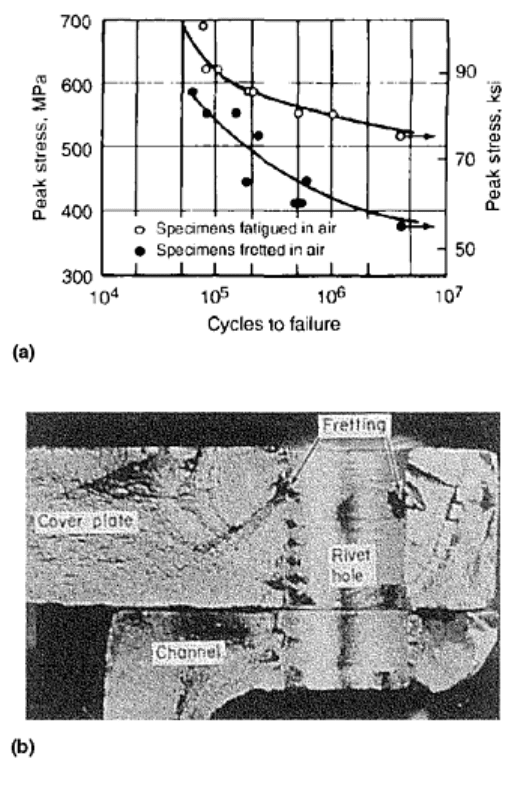
usually a very fine, reddish iron oxide; on aluminum, it is usually black. The debris from fretting of noble
metals does not oxidize.
Under fretting conditions, fatigue strength or endurance limits can be reduced by as much as 50 to 70% during
fatigue testing (e.g., see Fig. 1a). During fretting fatigue, cracks can initiate at very low stresses, well below the
fatigue limit of nonfretted specimens. In fatigue without fretting, the initiation of small cracks can represent
90% of the total component life. The wear mode known as fretting can cause surface microcrack initiation
within the first several thousand cycles, significantly reducing the component life. Additionally, cracks due to
fretting are usually hidden by the contacting components and are not easily detected. If conditions are favorable
for continued propagation of cracks initiated by fretting, catastrophic failure can occur (Fig. 1b). As such,
prevention of fretting fatigue is essential in the design process by eliminating or reducing slip between mated
surfaces.
Fig. 1 Effects of fretting. (a) Comparison of fatigue life for 4130 steel under fretting and nonfretting
conditions. Specimens were water quenched from 900 °C (1650 °F), tempered 1 h at 450 °C (840 °F), and
tested in tension-tension fatigue. Normal stress was 48.3 MPa (7 ksi); slip amplitude was 30–40 μm. (b)
Example of catastrophic fatigue due to fretting of a flanged joint
The initiation of fatigue cracks in fretted regions depends mainly on the state of stress in the surface,
particularly stresses caused by high friction. The direction of growth of the fatigue cracks is associated with the
direction of contact stresses and takes place in a direction perpendicular to the maximum principal stress in the
fretting area. After formation due to fretting, cracks propagate initially under shear (mode II) conditions under
the influence of the near-surface shear-stress field due to friction of fretting. Beyond that, tensile (mode I) crack
propagation under bulk cyclic stresses controls further propagation.
The topics covered in this article are:
• Mechanisms of fretting and fretting fatigue
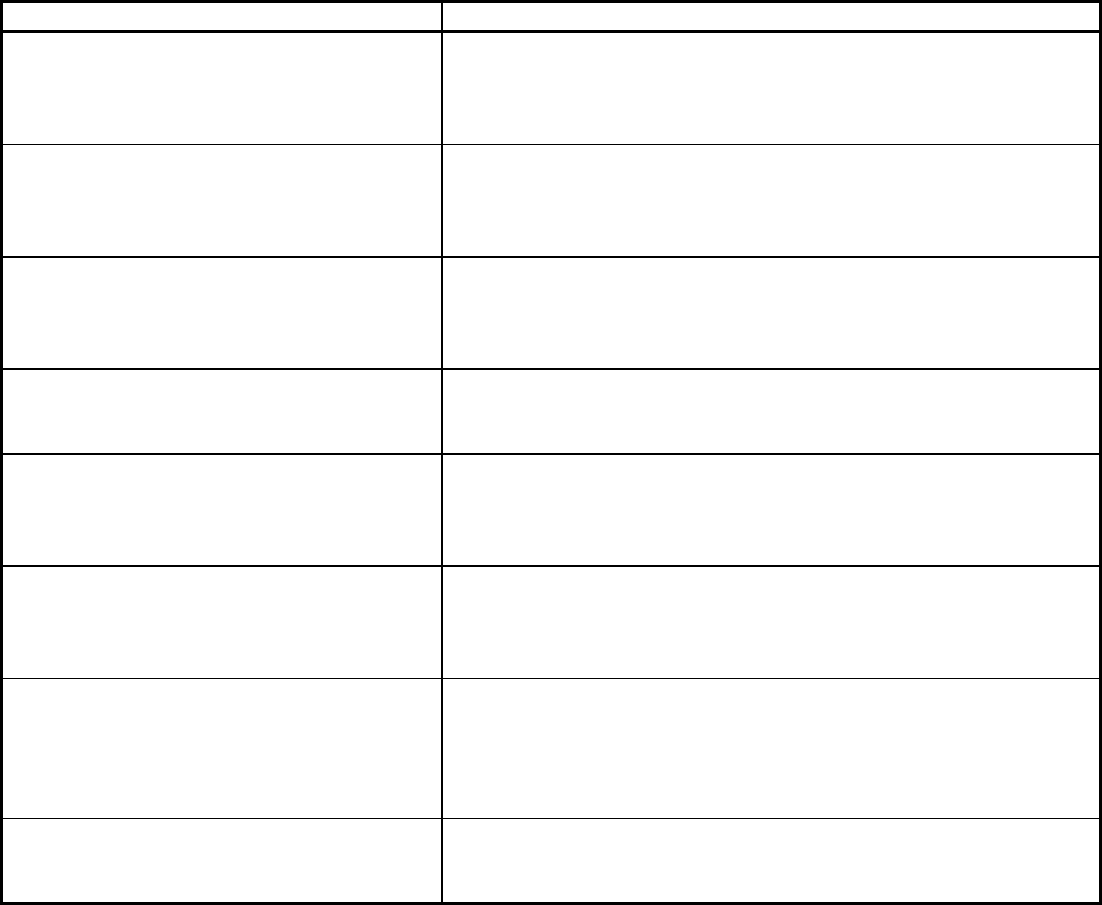
• Typical occurrences of fretting fatigue
• Fretting fatigue testing
• Prevention methods
Many investigators have contributed to the theoretical and practical research in the field of fretting and fretting
fatigue, and the information in this section is derived from their work. Several general texts are available (Ref
1, 2, 3, 4). Reference 5 is another key source for information and illustrations of fretting fatigue failures. In
addition, more current discussions and background are provided in the book Fretting Fatigue edited by R.B.
Waterhouse and T.C. Lindley. The article “On Fretting Maps” by O. Vingsbo and S. Söderberg is another
useful general reference on fretting. (See the Selected References for complete bibliographic information.)
As yet, general techniques or models permitting prediction of crack initiation due to fretting are limited.
However, an understanding of the factors contributing to fretting fatigue can help minimize the risk and extent
of damage. The examples presented in this article from case studies, theoretical work, and laboratory
investigations are intended to assist the reader in recognizing the potential for fretting fatigue in design and
materials selection. General principles and practical methods for the abatement or elimination of fretting fatigue
are summarized in Table 1. More recent information on fretting fatigue testing can be found in ASTM STP
1367 (listed under “Selected References” at the end of this article).
Table 1 Reduction or elimination of fretting fatigue
Principle of abatement ormitigation
Practical method
Reduction in surface shear forces
• Reduction in surface normal forces
• Reduction in coefficient of friction with coating or
lubricants
Reduction/elimination of stress
concentrations
• Large radii
• Material removal (grooving)
• Compliant spacers
Introduction of surface compressive stress
• Shot or bead blasting
• Interference fit
• Nitriding/heat treatment
Elimination of relative motion
• Increase in surface normal load
• Increase in coefficient of friction
Separation of surfaces
• Rigid spacers
• Coatings
• Compliant spacers
Elimination of fretting condition
• Drive oscillatory bearing
• Remove material from fretting contact (pin joints)
• Separation of surfaces (compliant spacers)
Improved wear resistance
• Surface hardening
• Ion implantation
• Soft coatings
• Slippery coatings
Reduction of corrosion • Anaerobic sealants
• Soft or anodic coatings

References cited in this section
1. R.B. Waterhouse, Ed., Fretting Fatigue, Applied Science, 1981
2. M.H. Attia and R.B. Waterhouse, Ed., Standardization of Fretting Fatigue Test Methods and
Equipment, STP 1159, ASTM, 1992
3. D.A. Hills and D. Nowell, Mechanics of Fretting Fatigue, Kluwer Academic Publishers, 1994
4. R.B. Waterhouse, Fretting Corrosion, Fretting Fatigue, Pergamon Press, 1972
5. Proc. Specialists Meeting on Fretting in Aircraft Systems, AGARD-CP-161, Advisory Group for
Aerospace Research and Development, 1974
Fretting Fatigue Testing
S.J. Shaffer and W.A. Glaeser, Battelle Memorial Institute
Fretting and Fretting Fatigue Mechanisms
In general, fretting occurs between two tight-fitting surfaces that are subjected to a cyclic, relative motion of
extremely small amplitude. Although certain aspects of the mechanism of fretting are still not thoroughly
understood, the fretting process is generally divided into the following three parts: initial conditions of surface
adhesion, oscillation accompanied by the generation of debris, and fatigue and wear in the region of contact.
Fretting wear occurs from repeated shear stresses that are generated by friction during small-amplitude
oscillatory motion or sliding between two surfaces pressed together in intimate contact. Surface cracks initiate
in the fretting wear region. The relative slip amplitude is typically less than 50 μm (0.002 in.), and
displacements as small as 10
-4
μm have produced fretting. Generation of fine wear debris that usually oxidizes
is an indication of fretting wear (Fig. 2). The following factors are known to influence the severity of fretting:
• Contact load. As long as fretting amplitude is not reduced, fretting wear will increase linearly with
increasing load.
• Amplitude. There appears to be no measurable amplitude below which fretting does not occur. However
if the contact conditions are such that deflection is only elastic, it is not likely that fretting damage will
occur. Fretting wear loss increases with amplitude. The effect of amplitude can be linear, or there can be
a threshold amplitude above which a rapid increase in wear occurs (Ref 4). The transition is not well
established and probably depends on the geometry of the contact.
• Frequency. When fretting is measured in volume of material removed per unit sliding distance, there
does not appear to be a frequency effect.
• Number of cycles. An incubation period occurs during which fretting wear is negligible. After the
incubation period, a steady-state wear rate is observed, and a more general surface roughening occurs as
fretting continues.
• Relative humidity. For materials that rust in air, fretting wear is higher in dry air than in saturated air.
• Temperature. The effect of elevated temperature on fretting depends on the oxidation characteristics of
the material.
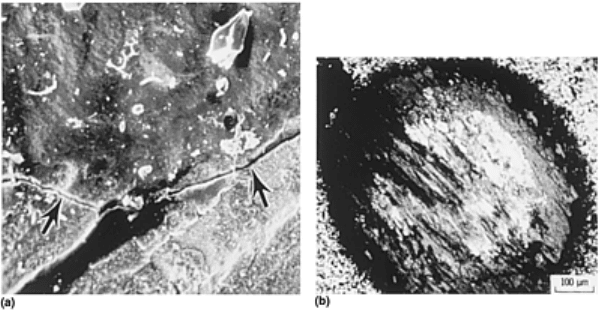
Fig. 2 Fretting wear scars. (a) On steel (arrows indicate fatigue crack). Courtesy of R.B. Waterhouse,
University of Nottingham. (b) On high-purity nickel. Courtesy of R.C. Bill, NASA Lewis Research
Center
In terms of fatigue, the following three primary variables contribute to shear stresses at the surface and, hence,
are important for crack initiation and initial propagation of fretting fatigue cracks:
• Normal load (e.g., contact pressure)
• Relative displacement (slip amplitude)
• Coefficient of friction
The other primary variable is the bulk tensile stresses that control crack propagation beyond the limit of the
surface-induced stress field. Secondary factors, including surface roughness, surface contaminants, contact size,
debris accumulation, and environment affect fretting fatigue through their influence on the primary variables.
Effective lubrication will reduce friction stresses and wear-particle accumulation.
Fretting Modes and Contact Conditions. The oscillatory motion responsible for fretting can be induced by
system vibrations or by cyclic loading of one of the components. The relative displacement can be either
amplitude controlled or load controlled, or a combination of both. Methods to control fretting fatigue depend on
which of these two modes dominates the contact conditions.
Stress Conditions. The nominal macroscopic normal stress between the two surfaces is defined by the normal
force divided by the nominal area of contact. Subsurface stress distributions can be computed using Hertzian
calculations and the macroscopic contact geometry. The normal stress is also influenced by geometric stress
concentrations. The real area of contact is limited to the contacting tips of the microscopic asperities on each of
the surfaces, and the local (microscopic) normal stress is dictated by the yield strength of the softer of the two
materials. Superimposed on the local normal stresses are shear stresses resulting from the friction of relative
displacement of the two contacting members. The magnitude of the shear stresses induced by asperity contact
depends on the coefficient of friction (due to adhesive forces between, and interpenetration of, asperities), the
local load, asperity geometry, the elastic moduli of the two surfaces, and the amplitude of relative displacement.
Strain Conditions. If the amplitude of oscillation is small, the shear strains are elastic, and the contact condition
is one of sticking or no slip. Even under microelastic displacements, fatigue cracks can form due to reverse
bending at the bases of the contacting asperities. If the amplitude of oscillation is large, depending on the
strength and ductility of the asperities in contact, and on the adhesive forces acting between them, the asperities
will be forced to pass over one another and slip occurs.
*
With slip, the possibility of wear exists from either
adhesion, abrasion, or delamination. All of these material-removal mechanisms lead to a roughening of the
surface, the creation of sites for crack initiation, and the generation of wear debris. Cracks can also be initiated
by pitting that occurs during fretting.
Conditions for Slip. The local contact conditions may be predominantly displacement controlled or load
controlled. In displacement-controlled fretting contacts undergoing full slip, the amplitude of motion is
controlled by the external displacements, an example being the relative displacement imposed on adjoining
strands of a wire rope passing over a pulley. For force-controlled fretting contacts, the displacement depends on
the macroscopic shear force, the normal force, and the coefficient of friction; for example, the mating forces of
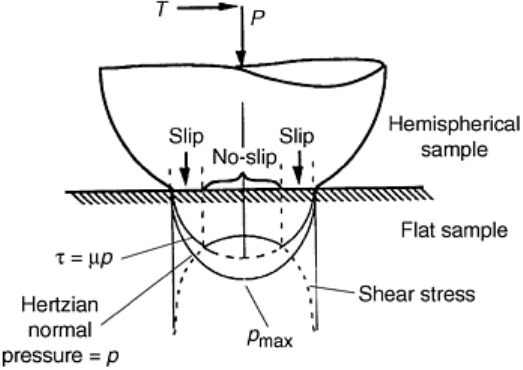
a bolted flange or a hub/shaft press fit interface. No slip occurs until the shear stress exceeds the product of the
normal force and local coefficient of friction. The condition for slip is met when
τ > μσ
n
(Eq 1)
where τ is the local shear stress, μ is the coefficient of friction between contacting surfaces, and σ
n
is the local
normal stress.
Regions of both slip and no-slip can occur at an interface of contacting solids. This is most easily seen for
convex contacts using the elastic stress analysis of a sphere pressed into a plate, as shown in Fig. 3 (Ref 6). The
normal (Hertzian) stress field is an elliptical distribution with the maximum stress occurring under the center of
the contact. The shear stresses, which promote relative slip, are a maximum at the edges of the contact (limited
by yielding) and a minimum in the center. The forces resisting sliding due to the shear stress are given by μN.
The condition pictured is known as partial slip. As μN is increased, the region of sticking expands, and vice
versa. When the shear forces of fretting are superimposed on this stress field, the result is a smaller “stick” area.
This analysis can also apply to a cylindrical contact or can be adapted to microscopic asperity contacts.
Fig. 3 Stress distribution for hemispherical contact pressed into flat plate. Source: Ref 6
For contact between nominally flat surfaces, the stress state is different, though the slip condition is still defined
by Eq 1. The macroscopic stress concentrations for well-defined geometries can be computed using finite-
element modeling (FEM) analysis, although wear will change the assumed contact geometry. A general
treatment of the subject can be found in Ref 3.
Fatigue-Crack Nucleation from Fretting. Crack nucleation due to fretting must involve a stress concentration or
discontinuity. At the microscopic level, examples include: microcracks formed at the base of asperities due to
reverse-bending fatigue of the asperities, stress concentrations in the pits left by sheared adhering “cold-
welded” asperity junctions, corrosion pits that form due to removal of protective oxides by fretting, grooves due
to abrasion, or delamination of a thin surface region whose work-hardening capacity has been exhausted. At the
macroscopic level, cracks are proposed to form solely as a result of geometric stress concentrations, usually at
the edges of the fretting contact region, where shear stresses are predicted to be highest, at some microscopic
inhomogeneity. The two views are not significantly different. The second view is more amenable to modeling
and FEM analysis.
The location of crack nucleation depends on the contact conditions. Under full-slip conditions, in the absence of
stress concentrations at the edge of the contact, cracks can nucleate anywhere in the contact region. The number
of asperity interactions per cycle depends on the asperity distribution (surface roughness) and the amplitude of
relative motion. Several cracks may be formed. Their stress fields can interact and lead to a decrease in the
stress field associated with a single crack. This may explain why multiple nonpropagating cracks are often
found in association with fretting. Under partial-slip conditions, the cracks always form at the border between
the slip and the no-slip regions. In this case, multiple cracks are proposed to result from the movement of the
slip/no-slip boundary due to the generation of debris (Ref 7). Though less likely, cracks can also form in the
region of no slip (full sticking) due to reciprocating subsurface shear stresses associated with reversing elastic
deformation of the contacting asperities and stress concentrations at their bases leading to local microplastic
deformation and fatigue.
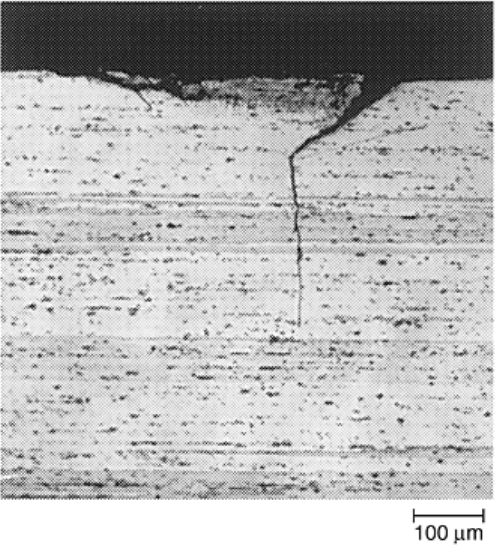
Fatigue-Crack Propagation during Fretting Fatigue. Crack propagation is initially driven by the stress state
dominated by the surface shearing. As such, when viewed in cross section, the crack direction initially appears
at an angle to the surface of between 35 and 55°. Mode II crack propagation dominates this region. The mode II
propagation may depend on material parameters such as grain size, texture, and phase morphology. Because the
surface shear stresses fall off rapidly with depth, the crack will either arrest, or, if static or alternating tensile
stresses exist in the bulk material, will change direction and run perpendicular to the surface as the driving
forces come under the control of the bulk tensile forces (Fig. 4). The depth at which this occurs depends on the
magnitude of the surface shear stresses, which depend on the coefficient of friction and normal contact stress.
For Hertzian stresses of convex contacts, this depth is on the order of the half-width of the contact area. Beyond
this depth, mode I crack propagation analysis can be used to predict the growth rate under the bulk stress state.
Fig. 4 Example of fretting fatigue crack viewed in cross section. Courtesy of R.B. Waterhouse,
University of Nottingham
A phenomenon peculiar to fretting is that some of the fatigue cracks do not propagate because the effect of
contact stress extends only to a very shallow depth below the fretted surface. At this point, favorable
compressive residual stresses retard or completely halt crack propagation. Under full-slip conditions, the wear
rate caused by fretting occasionally outpaces the growth rate of surface-initiated fatigue cracks. In this situation,
fretting wear preempts fretting fatigue.
Footnote
*
In fretting, the term slip is used to denote small-amplitude surface displacements. In contrast to sliding,
which
denotes macroscopic displacements. Additionally, in this article slip
does not refer to the mechanism of
fatigue resulting as a consequence of dislocation motion.
References cited in this section
3. D.A. Hills and D. Nowell, Mechanics of Fretting Fatigue, Kluwer Academic Publishers, 1994
4. R.B. Waterhouse, Fretting Corrosion, Fretting Fatigue, Pergamon Press, 1972
6. R.D. Mindlin, Compliance of Elastic Bodies in Contact, J. Appl. Mech., Vol 16, 1949, p 259–268
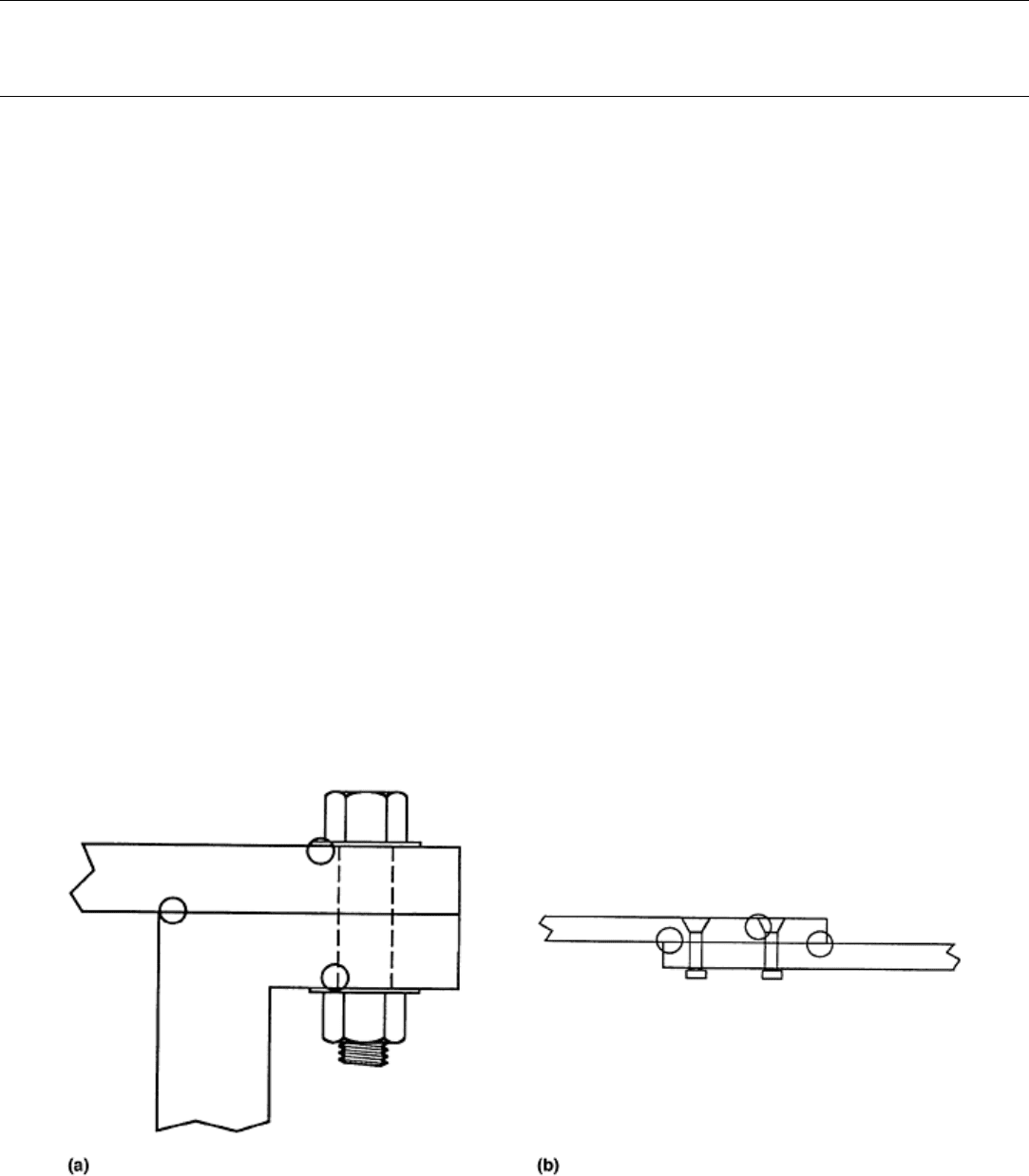
7. R.B. Waterhouse, Theories of Fretting Processes, Fretting Fatigue, Applied Science, 1981, p 203–220
Fretting Fatigue Testing
S.J. Shaffer and W.A. Glaeser, Battelle Memorial Institute
Typical Systems and Specific Remedies
Fretting generally occurs at contacting surfaces that are intended to be fixed in relation to each other but that
actually undergo minute alternating relative motion that is usually produced by vibration. Fretting generally
does not occur on contacting surfaces in continuous motion, such as ball or sleeve bearings. There are
exceptions, however, such as contact between balls and raceways in bearings and between mating surfaces in
oscillating bearings and flexible couplings. Common sites for fretting are in joints that are bolted, keyed,
pinned, press fitted, or riveted; in oscillating bearings, splines, couplings, clutches, spindles, and seals; in press
fits on shafts; and in universal joints, baseplates, shackles, and orthopedic implants.
Three general geometries and loading conditions for fretting fatigue are considered in this section:
• Parallel surfaces clamped together with some type of fastener, such as a bolted flange or riveted lap joint
• Parallel surfaces loaded by means of a press or interference fit, such as a gear or wheel on a shaft
• Convex contacts, as found beneath a convex washer, between crossed cylinders such as wire rope
strands, or a sphere or a cylinder in a bearing race
Specific remedies to reduce fretting are given for these common examples. When frettting occurs, it often
cannot be eliminated but can be reduced in severity.
Parallel Contact with External Loading (Fastened Joints). Bolted flanges in pipe systems are common locations
for fretting fatigue. Cracks can occur in the plate either under a bolt head or washer (load controlled), on the
inside diameter of the bolt through-hole (displacement controlled), or on the surface of one plate at the point of
contact with the end of the other plate (load controlled) (Fig. 5a). Lap joints are found in both heavy plates and
thin sheets such as aircraft skins. Fretting can occur in the joint or under the head of a countersunk screw, bolt,
or rivet (Fig. 5b).
Fig. 5 Typical location of fretting fatigue cracks in (a) a bolted flange, and (b) a lap joint
For both these geometries, the reduction or abatement of fretting severity depends on whether the motion is
load controlled or displacement controlled. If it is displacement controlled, then reducing the contact stress and

minimizing the coefficient of friction at the interface is recommended. For lap joints, however, a reduction in
the coefficient of friction may result in insufficient load transmitted by the interface, transferring the load to the
fasteners and leading to their failure. For load-controlled motions, it may be possible to increase either the
clamping force or the coefficient of friction to completely eliminate relative motion between the two contacting
members. While adhesives can be used to eliminate the relative motion, their use complicates future
disassembly. If motion cannot be completely eliminated, then minimizing the coefficient of friction may help,
although this will likely lead to an increased slip amplitude. Alternatively, a thin compliant layer, such as
rubber or other polymer, may be able to absorb the deflection and prevent contact between the two members.
For pin joints, fretting can occur on diagonally opposite sides of the pin at the points of contact with the hole
due to vibrations or reversing loads. In these cases, White (Ref 8) showed that an increase in fatigue strength
can be achieved by machining flats on the sides of the pins to prevent contact at the position of maximum
stress, thus removing the region where fretting occurs (Fig. 6).
Fig. 6 Pin joint. (a) Fretting locations. (b) Material removal to eliminate region of highest stress
Parallel Surfaces without External Loading. Hubs, flywheels, gears, and other types of press-fit wheels, pulleys,
or disks on shafts are subject to fretting fatigue caused by reverse bending strains compounded by the stress
concentration where the shaft meets the disk (Fig. 7a). The introduction of lubricant in the interface can make
matters worse by increasing the relative slip. In this case, it is best to attempt a strong interference fit. This can
be achieved through cooling the shaft and heating the bore of the hole during assembly in order to produce
sufficiently high normal stresses to completely eliminate slip within the interface. After assembly, both surfaces
will also be in a state of compressive stress, providing further resistance to fatigue-crack propagation. Finally, if
possible, a stress-relieving groove or large radius on the shaft (Fig. 7b) should be incorporated into the design.
Fig. 7 Wheel on shaft. (a) Location of fretting fatigue cracks. (b) Stress-reduction grooves
Gas-turbine rotor-blade roots and other dovetail joints are potential locations of fretting fatigue failures (Fig.
8a). In this case, the loading conditions are variable and depend on the rotational speed. For these situations,
stress-relieving grooves can be incorporated into the design (Fig. 8b). Coatings to reduce the coefficient of
friction (and hence the surface shear forces) can also help. Experiments by Ruiz and Chen on simulated
blade/disk dovetail joints at 600 °C (1112 °F) indicated that shot peening followed by electroplating with a 10
μm (394 μin.) thick Co/C surface layer was effective (Ref 9). Another example is provided in the article by
Johnson in Ref 5.
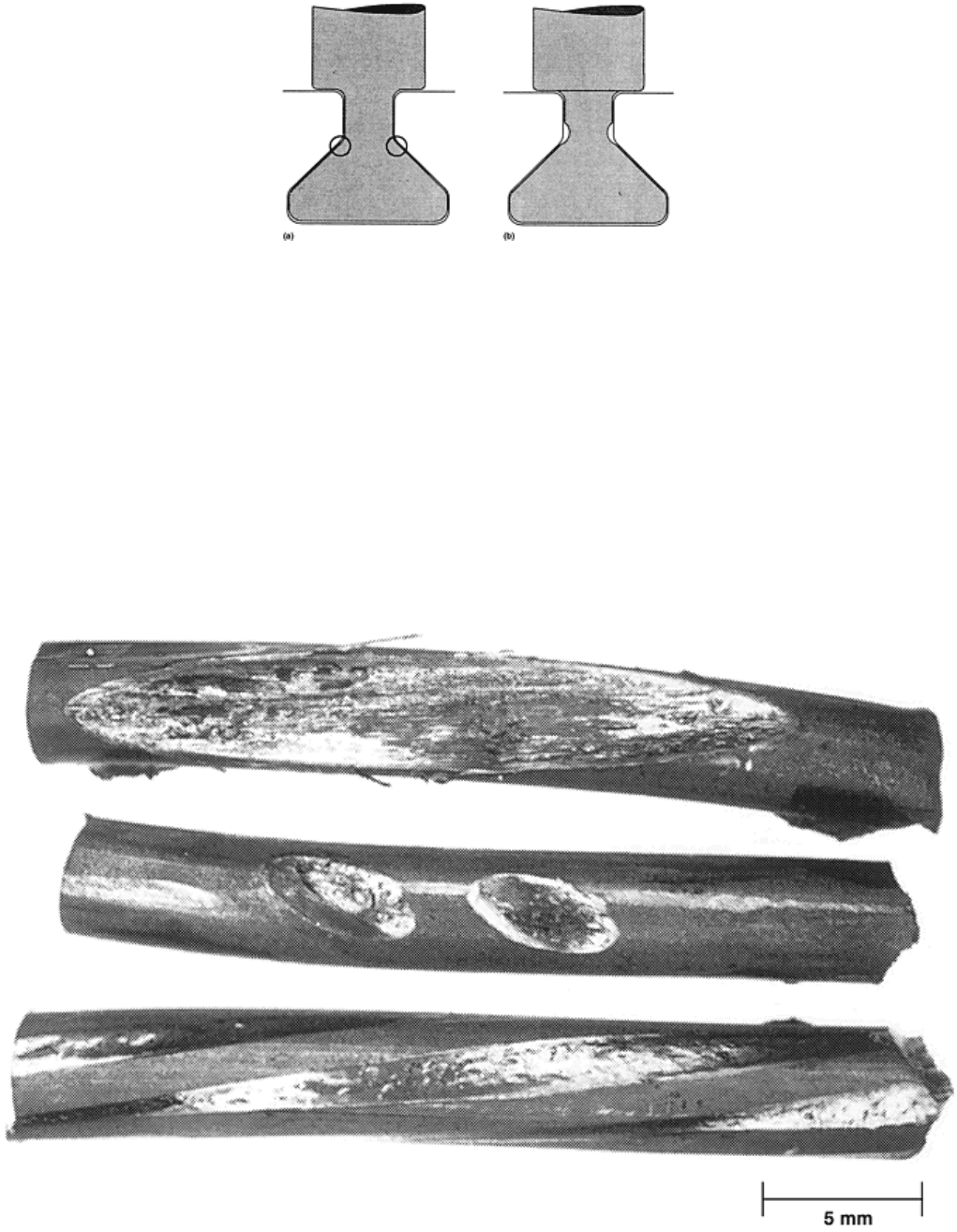
Fig. 8 Dovetail joint. (a) Location of fretting fatigue cracks. (b) Stress-reduction grooves
Convex Surfaces. Fretting fatigue in control cables or wire ropes is caused by small relative displacements
between the individual strands as the cable flexes in passing over pulleys, or by varying stresses from wind or
water currents (Fig. 9). Stainless steel control cables are particularly susceptible because of the high friction and
galling propensity between the strands. Fatigue fractures of the inner strands of the cables make detection by
visual inspection virtually impossible until the ends of the fractured strands pop out through the outer strands.
Wire rope fretting fatigue in control cables is an example of displacement-controlled contact. As such, large
pulley diameters as a function of cable cross section can be specified in the design in order to decrease the
displacement and minimize fretting fatigue. Incorporation of lubricant in the cable will reduce strand-to-strand
shear forces, but only as long as the lubricant is contained within the rope interior by the outer strands.
Takeuchi and Waterhouse report that electrodeposited zinc coatings helped prevent fretting fatigue of wire rope
in sea water (Ref 10). The zinc provides both a reduction in the effects of corrosion and a low-shear-strength
surface film that reduces friction.
Fig. 9 Examples of fretting on inner strands of drag-line wire rope
In rolling-element bearings, high Hertzian normal stresses occur beneath the contact of bearing balls in their
races. Control-system or oscillatory-pivot bearings are often subjected to a low-amplitude, but high-frequency,
dithering motion leading to fretting or false brinelling between the balls and the race. (The difference between
false brinelling and fretting is discussed in the article “Fretting Wear” in Friction, Lubrication, and Wear
